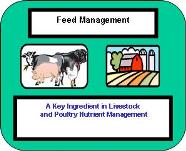Introduction
This fact sheet has been developed to support the implementation of the Natural Resources Conservation Service Feed Management 592 Practice Standard. The Feed Management 592 Practice Standard was adopted by NRCS in 2003 as another tool to assist with addressing resource concerns on livestock and poultry operations. Feed management can assist with reducing the import of nutrients to the farm and reduce the excretion of nutrients in manure.
Please check this link first if you are interested in organic or specialty dairy production
The Natural Resources Conservation Service has adopted a practice standard called Feed Management (592) and is defined as “managing the quantity of available nutrients fed to livestock and poultry for their intended purpose”. The national version of the practice standard can be found in a companion fact sheet entitled An Introduction to Natural Resources Conservation Service (NRCS) Feed Management Practice Standard 592. Please check in your own state for a state-specific version of the standard.
Mass balance is calculated as the difference between imported and exported mass across the farm boundary. Estimating mass balance can provide critical information for (comprehensive) nutrient management planning and to manage the movement of nutrients and manure. Estimation of whole-farm P mass balance is used to determine the acres of land needed for crop production to use manure P. Environmental risk to surface and ground waters is increased if the amount of P imported into the farm (e.g., from fertilizers, feeds, and animals) exceeds the amount of P exported from the farm (e.g., crops, animals, manure, milk, meat, eggs, and fibers).
In Table 1 are estimates of P excretion derived by mass balance calculations using standard diets, animal performance, and the acres needed for land application at a crop removal rate of 50 pounds P2O5/acre per year. Mass balance estimates vary among farms, depending upon specific inputs and outputs, and should be calculated specifically for each farm when doing nutrient management planning.
| Livestock Enterprise | Pounds P2O5 | Acres needed |
| Growing-finishing beef | 17,500 | 350 |
| Horses | 22,000 | 440 |
| Lactating dairy cows | 86,000 | 1,720 |
| Dairy heifers | 27,000 | 540 |
| Laying hens | 1,200 | 24 |
| Cow-calf beef | 48,000 | 960 |
| Sheep | 13,500 | 270 |
| Swine breeding herd with phytase | 37,000 | 740 |
| Swine growing-finishing with phytase | 3,600 | 72 |
| Turkeys with phytase | 1,300 | 26 |
Ways to affect P mass balance
Farms may consider moving manure off site to reduce P mass balance if not enough acreage is available. Additionally, potential feeding strategies to reduce P balance (and excretion), feed costs, and necessary land base include the following:
- Routinely complete laboratory analyses of feeds and re-balance rations as needed to meet animals’ P requirements.
- Formulate rations to meet the animal’s P requirements for maintenance, lactation, growth, and pregnancy. In general for a lactating Holstein cow, 1 gram of P for each pound of milk produced is sufficient to meet these combined requirements. Based on this, ration P should equal 0.32 to 0.38% in DM depending on feed intake and milk yield (NRC, 2001). Greater concentrations are not necessary unless feed intake is depressed.
- Beef and dairy cattle rations may not need P supplementation at all to meet the animals’ requirements if basal ration ingredients have high P concentrations. Discontinuing P supplementation may reduce land base required by 25 to 50% (depending on the amount of over-supplementation in the original feeding program).
- If typical rations (e.g., corn silage, soybean meal, alfalfa, and corn grain) contain more P than needed to meet requirements, and if land base is limiting, alternative feedstuffs should be considered. The cost of using alternative feedstuffs may be less than the cost of using common “least-cost” feeds and managing excess manure P.
- Swine and poultry are able to absorb only part of the P in diets, so formulate based on “available P.” Grains for swine and poultry can vary from 14 to 50% in available P. In contrast, over 90% of ration P is available to cattle and sheep due to rumen microbial phytase.
- Supplemental phytase in corn-soybean meal based-diets for swine and poultry increases the P availability so that 25 to 35% less total ration P is needed.
- Pelleting and reducing the particle size of rations can increase the efficiency of P use by swine and poultry by 5 to 10%.
- Formulating rations for specific production phases, genotypes and genders. “Phase- feeding” programs for growing swine, poultry and lactating dairy cows can reduce P imports and excretion at least by 5 to 10%.
References
National Research Council. 2001. Nutrient Requirements of Dairy Cattle. 7th rev. ed. Natl. Acad. Sci., Washington, DC.
“Extension programs and policies are consistent with federal and state laws and regulations on nondiscrimination regarding race, sex, religion, age, color, creed, national or ethnic origin; physical, mental or sensory disability; marital status, sexual orientation, or status as a Vietnam-era or disabled veteran. Evidence of noncompliance may be reported through your local Extension office.”
Disclaimer
This fact sheet reflects the best available information on the topic as of the publication date. Date 5-25-2007
This Feed Management Education Project was funded by the USDA NRCS CIG program. Additional information can be found at Feed Management Publications.
This project is affiliated with the LPELC.
Project Information
Detailed information about training and certification in Feed Management can be obtained from Joe Harrison, Project Leader, jhharrison@wsu.edu, or Becca White, Project Manager, rawhite@wsu.edu.
Author Information
David Beede
C.E. Meadows Professor
beede@msu.edu
Dale Rozeboom
Associate Professor
rozeboom@msu.edu
Department of Animal Science
Michigan State University
Reviewer Information
Brian Perkins – Consulting Nutritionist
Katherine Knowlton – Virginia Tech




